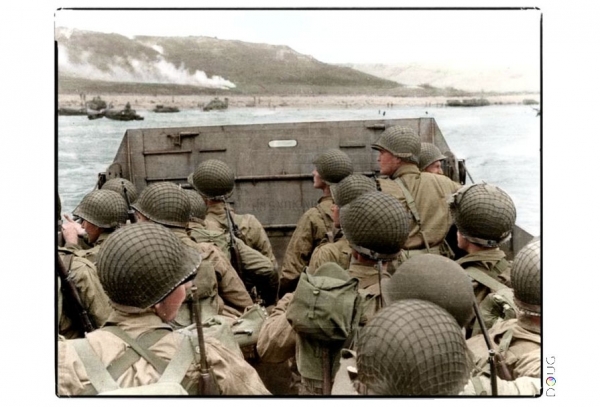 "The focal point of the attack apparently was aimed at Le Havre, the fine port at the mouth of the Seine. Nazi reports indicated a series of drives to cut the Brittany Peninsula with the center of gravity at Caen. It seemed certain that the Reich was awaiting news of other attacks."
"That was the way D-Day began, the second front the Allies had waited for for two years. It came like a shadow in the English midnight... The Nazi news agency, DNB, flashed the first story at 12:40 a.m. on June 6, Eastern wartime. Before dawn, British and American battleships were pounding shells into Havre, Caen and Cherbourg, high-booted skymen of the [88th] and 101st U.S.A. paratroop divisions had dropped into the limestone ridges of the Seine valley and landing barges filled with American, Canadian and British infantrymen nosed up to the beaches along the estuaries of the Orne and Seine rivers." Perched on the quarter deck of an LST off the coast of one of the American beachheads during the D-Day invasion, COLLIER'S war correspondent, W.B. Courtney, described the earliest hours of that remarkable day:
"I stared through my binoculars at some limp, dark bundles lying a little away from the main activities. In my first casual examination of the beach I had assumed they were part of the debris of defensive obstacles. But they were bodies - American bodies." The following is an extract from General Eisenhower's report on the Allied operations from June 6 through the 26 of August, 1944:
From Amazon:
 
"Many factors are woven into warp and woof of this great victory...One was the meticulous care in planning and preparation, another was the fact that we achieved some degree of surprise involving place, timing and strength of attack. The excellence and sufficiency of amphibious equipment, with measures for dealing with beach defenses and obstacles, was also important. In the air, the Luftwaffe has taken a fearful beating. Since June 6, 2378 German aircraft have been destroyed in the air and 1,167 on the ground..." If you ever wondered why The National W.W. II Museum is located in New Orleans rather than West Point, Annapolis or the nation's capitol - the answer can be spoken in two words: Andrew Higgins. Higgins was the innovator who designed and manufactured the landing crafts that made it possible for the Allied forces to land on all those far-flung beaches throughout the world and show those Fascists dogs a thing or two. His factory, Higgins Industries, was located on Lake Pontchartrain in New Orleans and it was for this reason that the museum board of directors chose to doff their collective caps, and erect their repository in his home town.
Attached is a five page photo-essay about Higgins and all that he was doing to aid in the war effort.
"About the Russians in Normandy...and they weren't much help to Adolf, either. Here are two stories, one of which tells how Russians, captured and forced to fight for the enemy, turned the tables on Jerry; the other which tells what happened when the Americans liberated Russian prisoners from a concentration camp."
|
MORE ARTICLES >>> PAGE: * 1 * 2 * 3 * 4 * 5 * > NEXT |
|